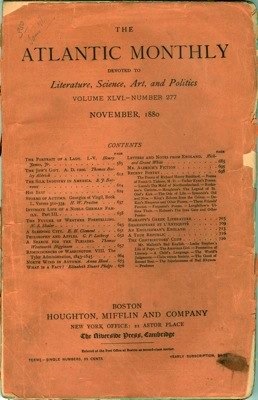At last night’s American graduate seminar in the English Faculty, Tamara Follini and Adrian Poole discussed their work on the Cambridge Edition of the Complete Fiction of Henry James. This ‘historical’ edition, based on the first editions rather than the texts that James selected and revised for the New York Edition, is expected to run to 30 volumes, under 34 separate editors. After six years, none of the volumes has yet appeared, although it’s clearly not for lack of sweat.
Adrian Poole took on The Princess Casamassima knowing that he would have to negotiate the relationship between the text as it appeared in instalments in the Atlantic Monthly and in subsequent volume publications, but only later learning (to his delight and horror) that there was also a surviving manuscript. This led him into the thorny thicket of James’s handwriting, and to a particular  letter in which James had apologized for the ‘…………. [word illegible] of my handwriting’. The what of my handwriting? After much staring and puzzling, Poole recovered the word: ‘anfractuosities’, meaning ‘winding or tortuous crevices, channels, passages’. (The OED helpfully points to Roderick Hudson, which refers to ‘chance anfractuosities of ruin in the upper portions
letter in which James had apologized for the ‘…………. [word illegible] of my handwriting’. The what of my handwriting? After much staring and puzzling, Poole recovered the word: ‘anfractuosities’, meaning ‘winding or tortuous crevices, channels, passages’. (The OED helpfully points to Roderick Hudson, which refers to ‘chance anfractuosities of ruin in the upper portions  of the Coliseum’). This was just one of the challenges presented by a text which was composed in England for serial publication in America, with proof sheets criss-crossing the Atlantic and the writer increasingly running late with his ‘too damnably voluminous’ submissions.
of the Coliseum’). This was just one of the challenges presented by a text which was composed in England for serial publication in America, with proof sheets criss-crossing the Atlantic and the writer increasingly running late with his ‘too damnably voluminous’ submissions.
The Wings of the Dove is Tamara Follini’s charge, and although the textual situation there is simpler, there is still an unresolved problem about whether to choose the English or the American first edition as copy-text. Cue hundreds of hours of variant-checking, sometimes over the kitchen table with other family members roped in to read aloud. Follini’s particular worry was annotation. The editors have vowed to refrain from offering purely interpretative notes, and to rein in any tendency to speculation, but this still leaves a question about how far one should go in glossing subtle literary allusions and intertextual references that might bear on a passage. Is there such a thing as a non-interpretative footnote? And how do you signal the presence of annotation without disrupting the reading experience and (at worst) upstaging the text?
For all their anxieties, these editors seemed to be enjoying their Herculean labours. Whatever else it may be, an edition is a declaration of love for a book or a writer; and Poole and Follini are still deeply in love with James.